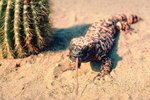
Visit a summertime beach or poolside and you're likely to find humans stretched out to enjoy the sun. Lizards also bask in the warm rays of sunlight, but their focus is on survival, not on getting a tan. Lizards lay out early in the morning, relying on the morning sun to jump-start their metabolism.
Regulating Body Temperature
Like all members of the reptile class, lizards are cold-blooded. That means their bodies do not generate stable internal temperatures like those of birds and mammals, warm-blooded animals. Cold-blooded creatures depend on the environment around them to control their body temperature. Lizards bask in the morning sun to raise their internal body temperature and stimulate their metabolism. They position their body to soak up maximum sunlight, spreading themselves to create more surface area. As their internal temperature warms up, their muscles become limber, which is crucial for hunting and escaping predators. If a lizard becomes too warm, it will move into a shady spot or burrow into cool soil.
Advantages to Being Cold-Blooded
Being cold-blooded gives reptiles a few advantages over warm-blooded animals. Warm-blooded animals have much higher metabolisms than reptiles and need to eat much more frequently to survive. If little food is available, lizards keep their body temperature low by staying out of the sun. This allows them to get by longer without food. Another advantage to being cold-blooded is less risk of infection by bacteria or viruses. Such organisms have a hard time surviving in an animal with drastic swings in body temperature.
Producing Vitamin D
Like all living creatures, reptiles need vitamin D to build healthy immune systems, strong bones and muscles, and to promote absorption of calcium and other minerals. Like birds and mammals, lizards in the sunshine convert ultraviolet B rays into vitamin D3. Researchers at Texas Christian University, who made the connection between reptile sunbathing and vitamin D production, suspect that a sensor in the lizard brain triggers instinctive sunbathing when the vitamin D level is low.
Hunting for Food
After cooling overnight, lizards lie in the morning sun to warm up enough for an early hunt. Lizards have two main hunting methods. Some species of lizards sit in one spot waiting for prey to come near, quickly snatching prey with the tongue. Other species actively hunt, looking for prey to stalk and catch. Both techniques require the lizard's muscles to be warm enough for quick response. Early morning basking prepares the lizard to find food before the sun becomes too hot.
References
Photo Credits
-
Hemera Technologies/Photos.com/Getty Images
Writer Bio
Living in California, Michelle Ullman is a professional writer with particular expertise in home, garden and pet/nature topics. Her work is published on many websites. She loves crafts and has a deep interest in design and DIY projects.



